Abstract
Poliovirus type 1 neurovirulence is difficult to analyze because of the 56 mutations which differentiate the neurovirulent Mahoney strain from the attenuated Sabin strain. We have isolated four neurovirulent mutants which differ from the temperature-sensitive parental Sabin 1 strain by only a few mutations, using selection for temperature resistance: mutant S(1)37C1 was isolated at 37.5 degrees C, S(1)38C5 was isolated at 38.5 degrees C, and S(1)39C6 and S(1)39C10 were isolated at 39.5 degrees C. All four mutants had a positive reproductive capacity at supraoptimal temperature (Rct+ phenotype). Mutant S(1)37C1 induced paralysis in two of four cynomolgus monkeys, and the three other mutants induced paralysis in four of four monkeys. The lesion score increased from the S(1)37C1 mutant to the S(1)39 mutants. To map the mutations associated with thermoresistance and neurovirulence, we sequenced all regions in which the Sabin 1 genome differs from the Mahoney genome. The S(1)37C1 mutant had one mutation in the 5' noncoding region and another in the 3' noncoding region. Mutant S(1)38C5 had these mutations plus another mutation in the 3D polymerase gene. The S(1)39 mutants had three additional mutations in the capsid protein region. The mutations were located at positions at which the Sabin 1 and Mahoney genomes differ, except for the mutation in the 5' noncoding region. The noncoding-region mutations apparently confer a low degree of neurovirulence. The 3D polymerase mutation, which distinguishes S(1)38C5 and S(1)39 mutants from S(1)37C1, is probably responsible for the high neurovirulence of S(1)38C5 and S(1)39 mutants. The capsid region mutations may contribute to the neurovirulence of the S(1)39 mutants, which was the highest among the mutants.
Full text
PDF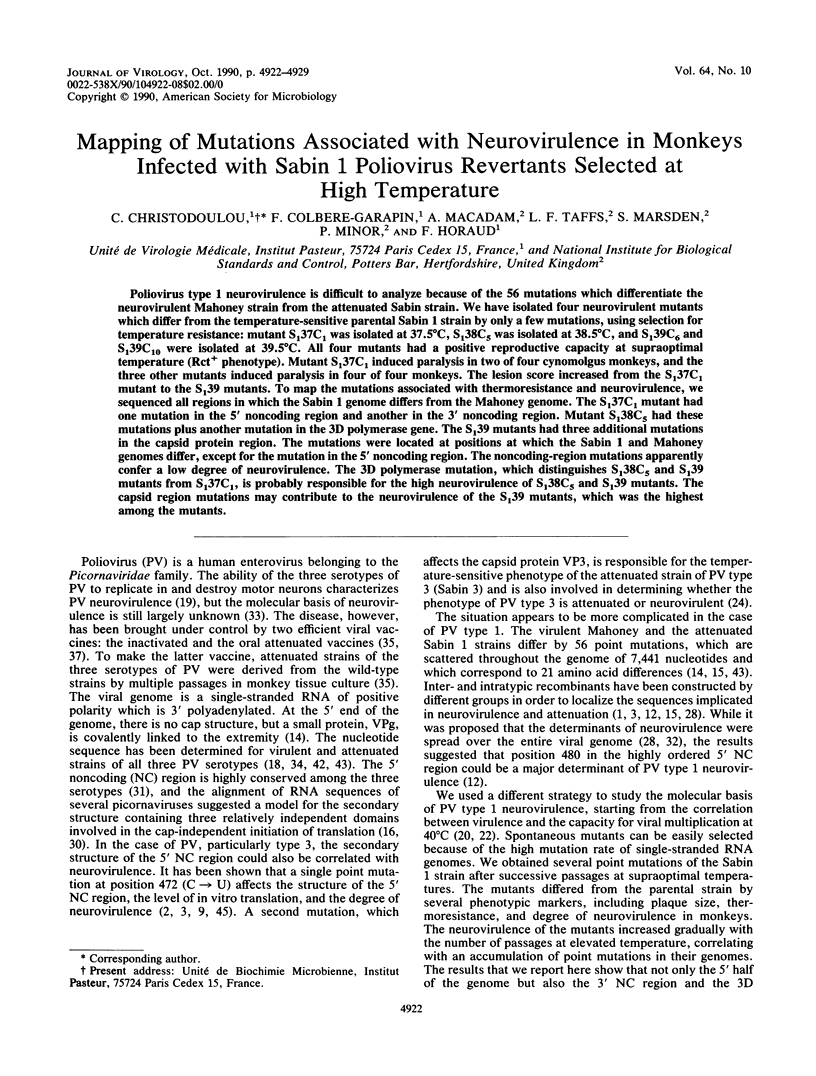
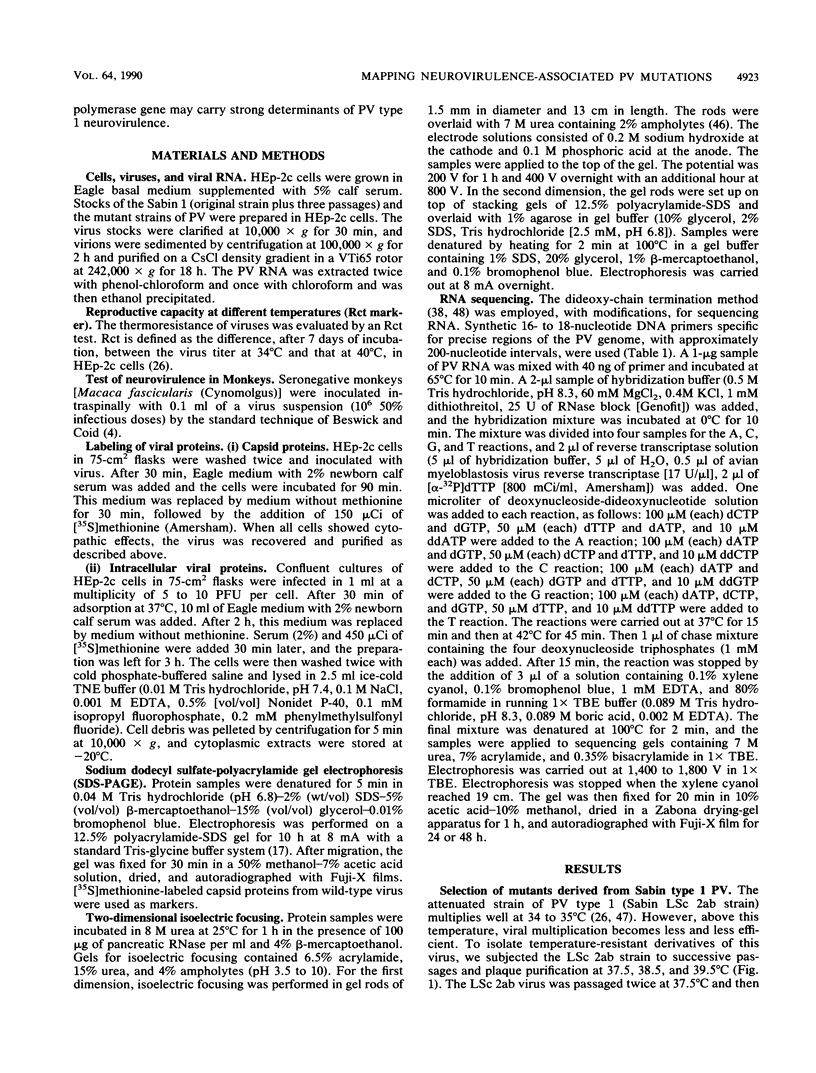
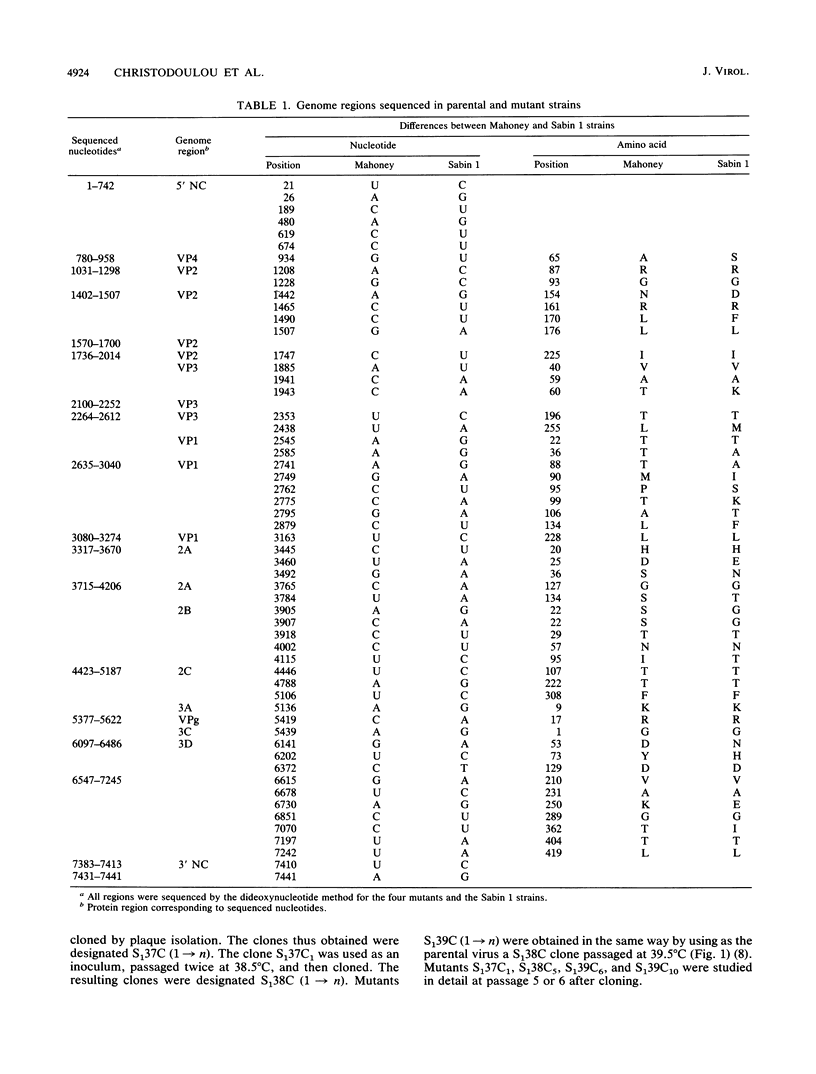
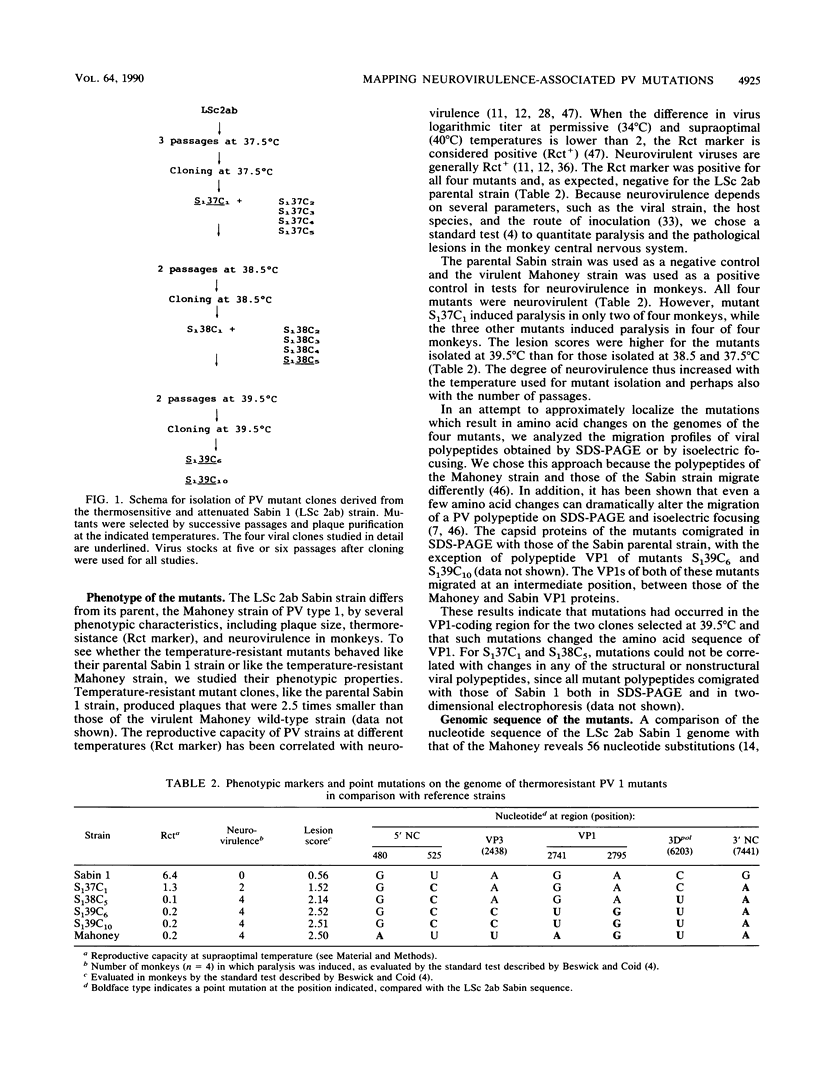
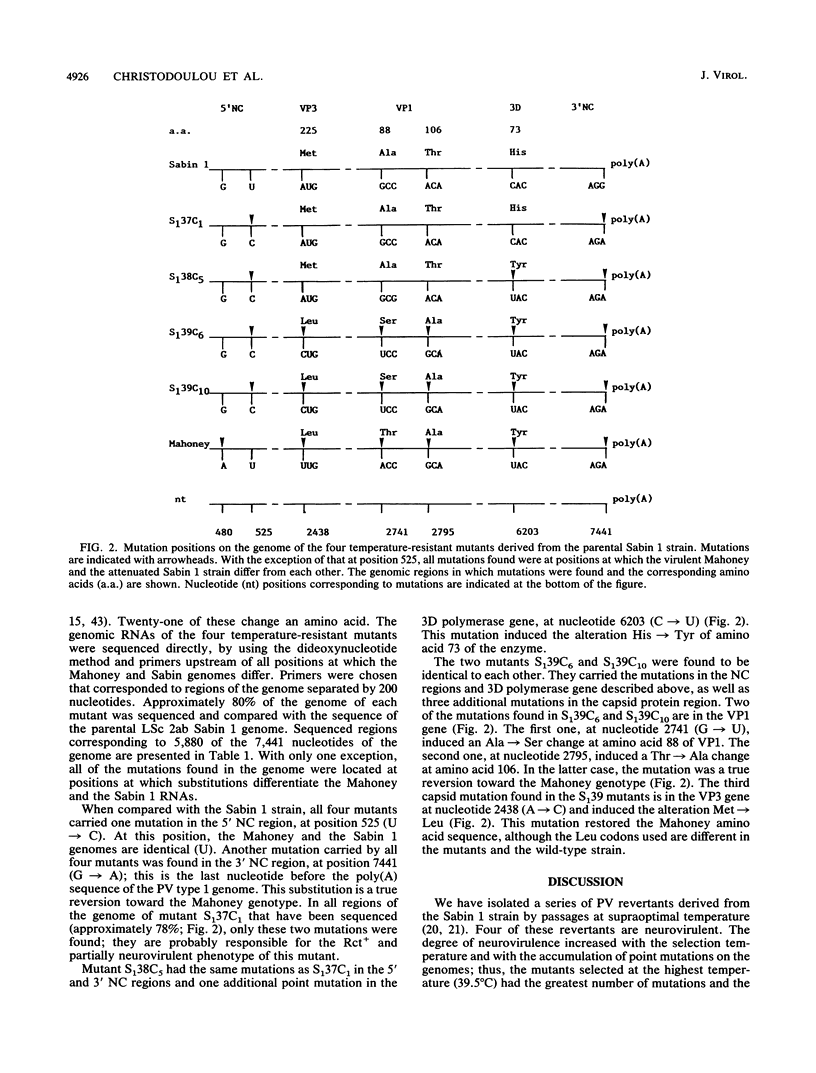
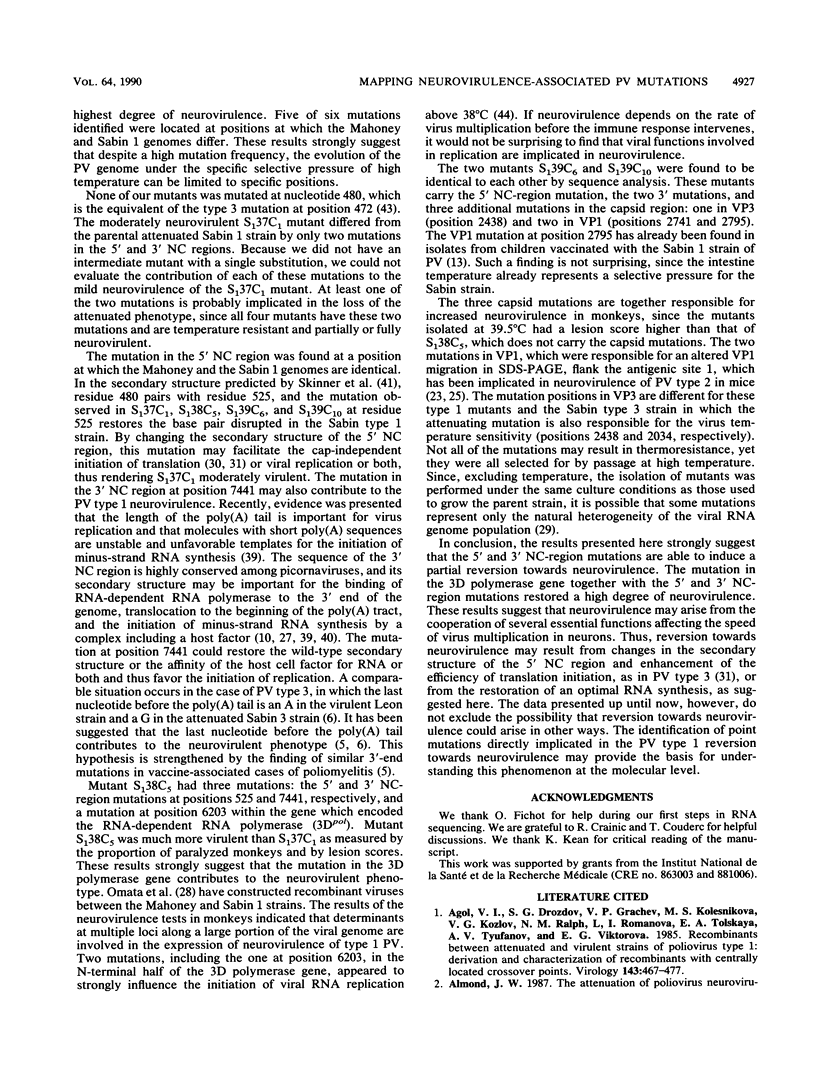
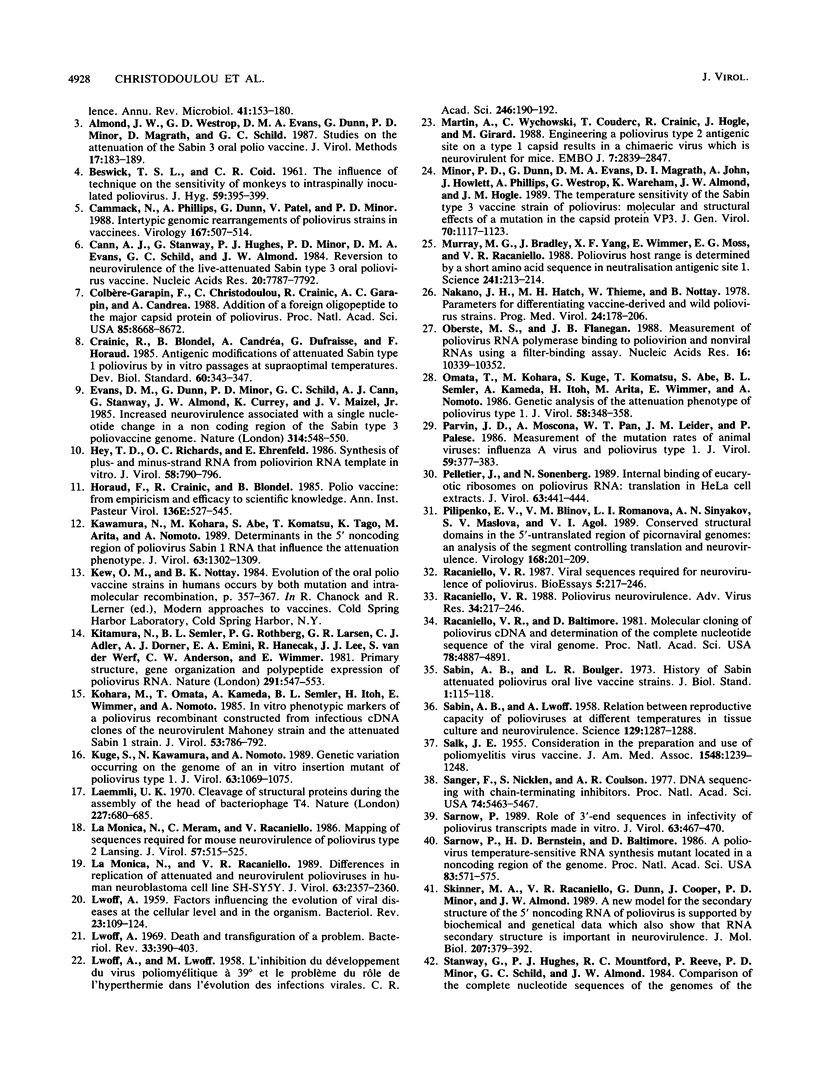
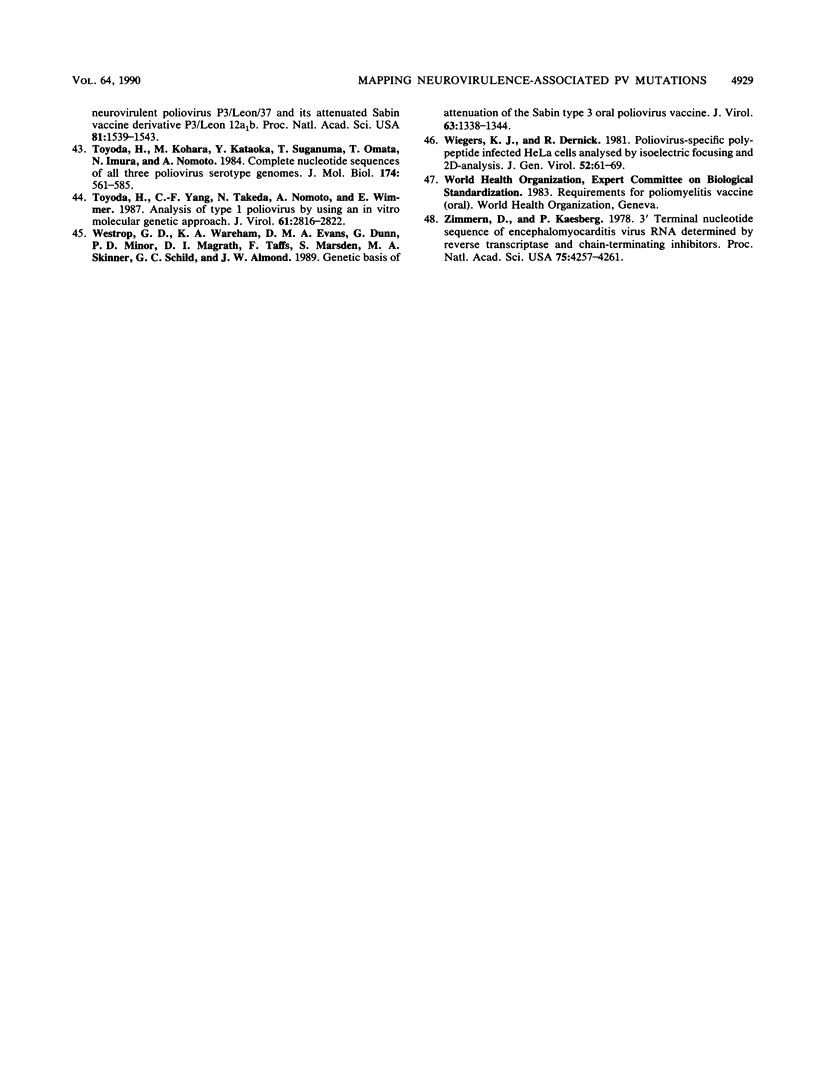
Selected References
These references are in PubMed. This may not be the complete list of references from this article.
- Agol V. I., Drozdov S. G., Grachev V. P., Kolesnikova M. S., Kozlov V. G., Ralph N. M., Romanova L. I., Tolskaya E. A., Tyufanov A. V., Viktorova E. G. Recombinants between attenuated and virulent strains of poliovirus type 1: derivation and characterization of recombinants with centrally located crossover points. Virology. 1985 Jun;143(2):467–477. doi: 10.1016/0042-6822(85)90386-1. [DOI] [PubMed] [Google Scholar]
- Almond J. W., Westrop G. D., Evans D. M., Dunn G., Minor P. D., Magrath D., Schild G. C. Studies on the attenuation of the Sabin type 3 oral polio vaccine. J Virol Methods. 1987 Aug;17(1-2):183–189. doi: 10.1016/0166-0934(87)90081-4. [DOI] [PubMed] [Google Scholar]
- BESWICK T. S., COID C. R. The influence of technique on the sensitivity of monkeys to intraspinally inoculated poliovirus. J Hyg (Lond) 1961 Dec;59:395–399. doi: 10.1017/s0022172400039085. [DOI] [PMC free article] [PubMed] [Google Scholar]
- Cammack N., Phillips A., Dunn G., Patel V., Minor P. D. Intertypic genomic rearrangements of poliovirus strains in vaccinees. Virology. 1988 Dec;167(2):507–514. [PubMed] [Google Scholar]
- Cann A. J., Stanway G., Hughes P. J., Minor P. D., Evans D. M., Schild G. C., Almond J. W. Reversion to neurovirulence of the live-attenuated Sabin type 3 oral poliovirus vaccine. Nucleic Acids Res. 1984 Oct 25;12(20):7787–7792. doi: 10.1093/nar/12.20.7787. [DOI] [PMC free article] [PubMed] [Google Scholar]
- Colbère-Garapin F., Christodoulou C., Crainic R., Garapin A. C., Candrea A. Addition of a foreign oligopeptide to the major capsid protein of poliovirus. Proc Natl Acad Sci U S A. 1988 Nov;85(22):8668–8672. doi: 10.1073/pnas.85.22.8668. [DOI] [PMC free article] [PubMed] [Google Scholar]
- Crainic R., Blondel B., Candréa A., Dufraisse G., Horaud F. Antigenic modification of attenuated Sabin type 1 poliovirus by in vitro passages at supraoptimal temperatures. Dev Biol Stand. 1985;60:343–347. [PubMed] [Google Scholar]
- Evans D. M., Dunn G., Minor P. D., Schild G. C., Cann A. J., Stanway G., Almond J. W., Currey K., Maizel J. V., Jr Increased neurovirulence associated with a single nucleotide change in a noncoding region of the Sabin type 3 poliovaccine genome. Nature. 1985 Apr 11;314(6011):548–550. doi: 10.1038/314548a0. [DOI] [PubMed] [Google Scholar]
- Hey T. D., Richards O. C., Ehrenfeld E. Synthesis of plus- and minus-strand RNA from poliovirion RNA template in vitro. J Virol. 1986 Jun;58(3):790–796. doi: 10.1128/jvi.58.3.790-796.1986. [DOI] [PMC free article] [PubMed] [Google Scholar]
- Kawamura N., Kohara M., Abe S., Komatsu T., Tago K., Arita M., Nomoto A. Determinants in the 5' noncoding region of poliovirus Sabin 1 RNA that influence the attenuation phenotype. J Virol. 1989 Mar;63(3):1302–1309. doi: 10.1128/jvi.63.3.1302-1309.1989. [DOI] [PMC free article] [PubMed] [Google Scholar]
- Kitamura N., Semler B. L., Rothberg P. G., Larsen G. R., Adler C. J., Dorner A. J., Emini E. A., Hanecak R., Lee J. J., van der Werf S. Primary structure, gene organization and polypeptide expression of poliovirus RNA. Nature. 1981 Jun 18;291(5816):547–553. doi: 10.1038/291547a0. [DOI] [PubMed] [Google Scholar]
- Kohara M., Omata T., Kameda A., Semler B. L., Itoh H., Wimmer E., Nomoto A. In vitro phenotypic markers of a poliovirus recombinant constructed from infectious cDNA clones of the neurovirulent Mahoney strain and the attenuated Sabin 1 strain. J Virol. 1985 Mar;53(3):786–792. doi: 10.1128/jvi.53.3.786-792.1985. [DOI] [PMC free article] [PubMed] [Google Scholar]
- Kuge S., Kawamura N., Nomoto A. Genetic variation occurring on the genome of an in vitro insertion mutant of poliovirus type 1. J Virol. 1989 Mar;63(3):1069–1075. doi: 10.1128/jvi.63.3.1069-1075.1989. [DOI] [PMC free article] [PubMed] [Google Scholar]
- LWOFF A. Factors influencing the evolution of viral diseases at the cellular level and in the organism. Bacteriol Rev. 1959 Sep;23(3):109–124. doi: 10.1128/br.23.3.109-124.1959. [DOI] [PMC free article] [PubMed] [Google Scholar]
- LWOFF A., LWOFF M. L'inhibition du développement du virus poliomyélitique à 39 degrees et le problème du rôle de l'hyperthermie dans l'évolution des infections virales. C R Hebd Seances Acad Sci. 1958 Jan 6;246(1):190–192. [PubMed] [Google Scholar]
- La Monica N., Meriam C., Racaniello V. R. Mapping of sequences required for mouse neurovirulence of poliovirus type 2 Lansing. J Virol. 1986 Feb;57(2):515–525. doi: 10.1128/jvi.57.2.515-525.1986. [DOI] [PMC free article] [PubMed] [Google Scholar]
- La Monica N., Racaniello V. R. Differences in replication of attenuated and neurovirulent polioviruses in human neuroblastoma cell line SH-SY5Y. J Virol. 1989 May;63(5):2357–2360. doi: 10.1128/jvi.63.5.2357-2360.1989. [DOI] [PMC free article] [PubMed] [Google Scholar]
- Laemmli U. K. Cleavage of structural proteins during the assembly of the head of bacteriophage T4. Nature. 1970 Aug 15;227(5259):680–685. doi: 10.1038/227680a0. [DOI] [PubMed] [Google Scholar]
- Lwoff A. Death and transfiguration of a problem. Bacteriol Rev. 1969 Sep;33(3):390–403. doi: 10.1128/br.33.3.390-403.1969. [DOI] [PMC free article] [PubMed] [Google Scholar]
- Martin A., Wychowski C., Couderc T., Crainic R., Hogle J., Girard M. Engineering a poliovirus type 2 antigenic site on a type 1 capsid results in a chimaeric virus which is neurovirulent for mice. EMBO J. 1988 Sep;7(9):2839–2847. doi: 10.1002/j.1460-2075.1988.tb03140.x. [DOI] [PMC free article] [PubMed] [Google Scholar]
- Minor P. D., Dunn G., Evans D. M., Magrath D. I., John A., Howlett J., Phillips A., Westrop G., Wareham K., Almond J. W. The temperature sensitivity of the Sabin type 3 vaccine strain of poliovirus: molecular and structural effects of a mutation in the capsid protein VP3. J Gen Virol. 1989 May;70(Pt 5):1117–1123. doi: 10.1099/0022-1317-70-5-1117. [DOI] [PubMed] [Google Scholar]
- Murray M. G., Bradley J., Yang X. F., Wimmer E., Moss E. G., Racaniello V. R. Poliovirus host range is determined by a short amino acid sequence in neutralization antigenic site I. Science. 1988 Jul 8;241(4862):213–215. doi: 10.1126/science.2838906. [DOI] [PMC free article] [PubMed] [Google Scholar]
- Nakano J. H., Hatch M. H., Thieme M. L., Nottay B. Parameters for differentiating vaccine-derived and wild poliovirus strains. Prog Med Virol. 1978;24:178–206. [PubMed] [Google Scholar]
- Oberste M. S., Flanegan J. B. Measurement of poliovirus RNA polymerase binding to poliovirion and nonviral RNAs using a filter-binding assay. Nucleic Acids Res. 1988 Nov 11;16(21):10339–10352. doi: 10.1093/nar/16.21.10339. [DOI] [PMC free article] [PubMed] [Google Scholar]
- Omata T., Kohara M., Kuge S., Komatsu T., Abe S., Semler B. L., Kameda A., Itoh H., Arita M., Wimmer E. Genetic analysis of the attenuation phenotype of poliovirus type 1. J Virol. 1986 May;58(2):348–358. doi: 10.1128/jvi.58.2.348-358.1986. [DOI] [PMC free article] [PubMed] [Google Scholar]
- Parvin J. D., Moscona A., Pan W. T., Leider J. M., Palese P. Measurement of the mutation rates of animal viruses: influenza A virus and poliovirus type 1. J Virol. 1986 Aug;59(2):377–383. doi: 10.1128/jvi.59.2.377-383.1986. [DOI] [PMC free article] [PubMed] [Google Scholar]
- Pelletier J., Sonenberg N. Internal binding of eucaryotic ribosomes on poliovirus RNA: translation in HeLa cell extracts. J Virol. 1989 Jan;63(1):441–444. doi: 10.1128/jvi.63.1.441-444.1989. [DOI] [PMC free article] [PubMed] [Google Scholar]
- Pilipenko E. V., Blinov V. M., Romanova L. I., Sinyakov A. N., Maslova S. V., Agol V. I. Conserved structural domains in the 5'-untranslated region of picornaviral genomes: an analysis of the segment controlling translation and neurovirulence. Virology. 1989 Feb;168(2):201–209. doi: 10.1016/0042-6822(89)90259-6. [DOI] [PubMed] [Google Scholar]
- Racaniello V. R., Baltimore D. Molecular cloning of poliovirus cDNA and determination of the complete nucleotide sequence of the viral genome. Proc Natl Acad Sci U S A. 1981 Aug;78(8):4887–4891. doi: 10.1073/pnas.78.8.4887. [DOI] [PMC free article] [PubMed] [Google Scholar]
- Racaniello V. R. Poliovirus neurovirulence. Adv Virus Res. 1988;34:217–246. doi: 10.1016/s0065-3527(08)60519-9. [DOI] [PubMed] [Google Scholar]
- SALK J. E. Considerations in the preparation and use of poliomyelitis virus vaccine. J Am Med Assoc. 1955 Aug 6;158(14):1239–1248. doi: 10.1001/jama.1955.02960140001001. [DOI] [PubMed] [Google Scholar]
- Sanger F., Nicklen S., Coulson A. R. DNA sequencing with chain-terminating inhibitors. Proc Natl Acad Sci U S A. 1977 Dec;74(12):5463–5467. doi: 10.1073/pnas.74.12.5463. [DOI] [PMC free article] [PubMed] [Google Scholar]
- Sarnow P., Bernstein H. D., Baltimore D. A poliovirus temperature-sensitive RNA synthesis mutant located in a noncoding region of the genome. Proc Natl Acad Sci U S A. 1986 Feb;83(3):571–575. doi: 10.1073/pnas.83.3.571. [DOI] [PMC free article] [PubMed] [Google Scholar]
- Sarnow P. Role of 3'-end sequences in infectivity of poliovirus transcripts made in vitro. J Virol. 1989 Jan;63(1):467–470. doi: 10.1128/jvi.63.1.467-470.1989. [DOI] [PMC free article] [PubMed] [Google Scholar]
- Skinner M. A., Racaniello V. R., Dunn G., Cooper J., Minor P. D., Almond J. W. New model for the secondary structure of the 5' non-coding RNA of poliovirus is supported by biochemical and genetic data that also show that RNA secondary structure is important in neurovirulence. J Mol Biol. 1989 May 20;207(2):379–392. doi: 10.1016/0022-2836(89)90261-1. [DOI] [PubMed] [Google Scholar]
- Stanway G., Hughes P. J., Mountford R. C., Reeve P., Minor P. D., Schild G. C., Almond J. W. Comparison of the complete nucleotide sequences of the genomes of the neurovirulent poliovirus P3/Leon/37 and its attenuated Sabin vaccine derivative P3/Leon 12a1b. Proc Natl Acad Sci U S A. 1984 Mar;81(5):1539–1543. doi: 10.1073/pnas.81.5.1539. [DOI] [PMC free article] [PubMed] [Google Scholar]
- Toyoda H., Kohara M., Kataoka Y., Suganuma T., Omata T., Imura N., Nomoto A. Complete nucleotide sequences of all three poliovirus serotype genomes. Implication for genetic relationship, gene function and antigenic determinants. J Mol Biol. 1984 Apr 25;174(4):561–585. doi: 10.1016/0022-2836(84)90084-6. [DOI] [PubMed] [Google Scholar]
- Toyoda H., Yang C. F., Takeda N., Nomoto A., Wimmer E. Analysis of RNA synthesis of type 1 poliovirus by using an in vitro molecular genetic approach. J Virol. 1987 Sep;61(9):2816–2822. doi: 10.1128/jvi.61.9.2816-2822.1987. [DOI] [PMC free article] [PubMed] [Google Scholar]
- Westrop G. D., Wareham K. A., Evans D. M., Dunn G., Minor P. D., Magrath D. I., Taffs F., Marsden S., Skinner M. A., Schild G. C. Genetic basis of attenuation of the Sabin type 3 oral poliovirus vaccine. J Virol. 1989 Mar;63(3):1338–1344. doi: 10.1128/jvi.63.3.1338-1344.1989. [DOI] [PMC free article] [PubMed] [Google Scholar]
- Wiegers K. J., Dernick R. Poliovirus-specific polypeptides in infected HeLa cells analysed by isoelectric focusing and 2D-analysis. J Gen Virol. 1981 Jan;52(Pt 1):61–69. doi: 10.1099/0022-1317-52-1-61. [DOI] [PubMed] [Google Scholar]
- Zimmern D., Kaesberg P. 3'-terminal nucleotide sequence of encephalomyocarditis virus RNA determined by reverse transcriptase and chain-terminating inhibitors. Proc Natl Acad Sci U S A. 1978 Sep;75(9):4257–4261. doi: 10.1073/pnas.75.9.4257. [DOI] [PMC free article] [PubMed] [Google Scholar]


